Available Physiotherapy Services
Physiotherapy Saskatoon
Therapy for Vertigo, Balance & Dizziness
TMD/TMJ - Jaw Treatment
Concussion Management
IMS/Dry Needling
Infant Torticollis and Plagiocephaly
Kinesiology/Exercise Therapy
Virtual Physiotherapy
Do not let pain, stiffness, or dizziness affect your quality of life
Physiotherapy Learning
Unveiling the Full Spectrum of Care at North 49 Physical Therapy
In the realm of healthcare, it's not uncommon for a reputation to precede a facility. At North 49, our expertise in treating dizziness has become a...
Clenching: Unveiling the Impact on Your Teeth and Jaw
In the hustle and bustle of daily life, it's common for people to find outlets for their stress and tension. Unfortunately, some individuals...
Maximize Your New Year’s Resolutions: Expert Kinesiology Support Inside
As the year draws to a close, many of us reflect on the past and look forward to the future. New Year's resolutions often revolve around...
Meet Our Team – Saskatoon Physiotherapy Clinic
North 49 Physical Therapy Clinic
North 49 Physical Therapy / Balance & Dizziness Centre
19-2105 8th St E, Saskatoon, SK, S7H 0T8
View on Google Maps
CONTACT & HOURS
Phone: 306-343-7776
Fax: 306-343-7780
Monday to Friday: 9am-6pm
Locally Owned & Operated










